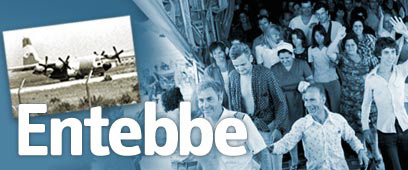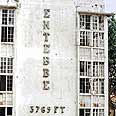

Special: Mossad took photos, Entebbe Operation was on its way
Even after 30 years, Muki Betser and Alik Ron haven’t forgotten even a single detail. Talking to Ynet, two former Matkal elite commando unit fighters, who took part in operation that became a legend, recount the chain of events of the summer of 1976
Saturday afternoon, July 1976: A few hours remain before one of the most dangerous and complex operations ever performed by the Matkal commando unit. The fighters, following endless briefings, are huddled at the Air Force base next to Lod, ready for take off. But the commander of the assault force, Muki Betser, is missing one piece of the intelligence puzzle. He knows that the success of the operation in Entebbe lies in getting an up-to-date aerial photo of the airport terminal in Uganda. But the photos he holds in his hand are five years old. The risk of encountering surprises on the ground, 1,400 kilometers from Israel, is ever present.
Only now, 30 years after the operation, Betser reveals for the first time in an interview with Ynet, the details of an aerial photo shoot that preceded the Entebbe Operation. The job in this case was done by the Mossad operatives. “On our team, there was a Mossad official called Shlomo Gal,” says Betser. “I asked him: Shlomo, can you get a plane over there to take some photos? And he tells me – yes.”
The defense establishment was getting ready to carry out an “operation inside an operation”. Betser recounts: “We took a Mossad operative, a pilot, whose job was to carry out different photo shoots for them in all kinds of places. He flew from London to Nairobi in Kenya. At Nairobi, he rented a light airplane, flew to Entebbe – and then informed the control tower he had a technical malfunction and had to perform some aerial roundabouts in the air.”
The Ugandans did not suspect a thing, despite the hijack drama that was unfolding at the airport. “The Mossad operative made a couple of rounds and photographed the old terminal. Afterwards he told the control tower that he could not land, went back to Nairobi and sent the photos to Israel,” says Betser. Eventually, the photos arrived at the last minute, on Saturday afternoon, only a few hours before the Matkal fighters were on their way.
The 30 years that have passed since the Entebbe Operation did not blur the memories. Muki Betser, the commander of the assault team and one of the operation planners, and Alik Ron, who was a reserve officer at the unit and took part in the operation, remember to this day every minute from the moment the plane hijack was announced until the moment they landed back in Israel with the passengers – but without their friend, the commander of the elite unit, Yoni Netanyahu. They say today that they do not view the Entebbe Operation as a mark of exceptional bravery and they do not like the myth that has become associated with it. For them, it is an operation that exemplifies the essence of Zionism.
And then, a young officer barged into the room
Sunday, June 27, 1976. Major Muki Betser, reserve commander of Matkal commando unit is on call as duty commander. Four commanders in the unit were qualified for the position, including Betser and Yoni Netanyahu. The essence of the role is to command an expeditionary force in case of terrorist attacks and negotiations. Alik Ron, then a captain, serves as a reserve platoon commander in the unit and is called to take part in the exercise.
It is quiet that morning. Betser arrives, verifies that the expeditionary force is properly briefed and drives to a staff meeting at the government campus in Tel Aviv. At 1:00 p.m., the door opens suddenly. A young officer barges into the conference room and informs Betser that a plane with Israeli passengers has been hijacked. “The team is sent immediately to Ben-Gurion airport and I race there from the Kirya,” says Betser. “In effect, we start preparing for the possibility that the plane will land at the airport – and we will perform a takeover. Ironically enough, just a month earlier we had conducted a similar exercise.”
Intelligence starts to flow in, but the big picture is still not clear. The fog clears up only after information is received that one of the passengers, an Israeli called Patricia with a British passport, was released after she wounded herself in the groin and made up a story about being in the initial months of a pregnancy. “We send men from the Mossad to London,” says Betser. “They meet her, and the scene she describes is such: The plane made an interim landing in Athens, which was not planned. It is an Air France plane, an Airbus, with 220 or so passengers, half of them are Jewish and Israeli. In Greece, about 30 passengers disembark, and 50 others get on board, including the four terrorists. Minutes after the plane takes off, just when the direction that safety belts can be unbuckled is given, the four terrorists burst to the passageways. Two run towards the cockpit and two head towards the passengers, while threatening with grenades, pistols and a machine gun. They hijack the plane and change its call name on the radio to “Haifa One.”
The State of Israel undergoes almost two full days of stress. And then Betser gets a phone call from someone he knows well: Ehud Barak, then Colonel and assistant to the head of intelligence for research and special operations. Barak, who commanded the elite unit three years prior, calls Betser to come in urgently. “A planning team is being formed to consider what to do with the plane that landed in Entebbe, at the international airport of Uganda. Ehud knew that I stayed four months in Uganda. At the beginning of the discussion he asks me: What is the quality level of the Ugandan soldiers? I reply: If I would have stayed longer than four months, they would have been much better.” The participants burst in laughter, and the planning begins.
Betser, who had trained the Ugandans as part of an IDF mission, reveals to those present that the airport was built by the Israeli construction company “Solel Boneh,” and the blueprints are in Israel. On that same night, the Entebbe intelligence file starts to take shape, in deep secrecy. Besides the eight people that take part in the planning, no one else is made aware of the operation. The file is classified at the highest level.
Choosing the operation plan
Out of the ideas that are raised by the team members, operation plans are being formulated. At the same time, a diplomatic effort is underway to release the passengers. The kidnappers transfer a list of prisoners imprisoned in Israel, which they demand to be released. The former head of the military mission to Uganda, Baruch (Burka) Bar Lev, who up until the expulsion of the Israeli mission from Uganda was best friends with the ruler Idi Amin, talks to him and “assures” that should he lead to the release of the passengers, he will win a Nobel prize. Amin, on his behalf, calms him down, and claims that he is guarding the hostages, and as long as Israel negotiates through him everything will be alright.
Based on the intelligence and the conversation Bar Lev holds with Amin, plans are taking shape:
Plan number one proposed to get to Entebbe in an Air Force Boeing airplane, in which soldiers will be disguised as terrorists released from the Israeli jail. The plane will take off to Entebbe, following the “success” of the diplomatic negotiations. At the airport the soldiers will rush from the airplane, take over the terminal and free the hostages.
Plan number two proposed parachuting boats to the immense Lake Victoria. From there a force of Israeli Navy Seals, supported by a small Matkal commando team, will sail to the beach. The distance from the beach to the outskirts of the airport is only one kilometer. After the arrival, the force would infiltrate the terminal, hit the terrorists and free the hostages.
According to the third plan, the force would fly to Nairobi in Kenya, and from there sail in a yacht (rented ahead of time by Mossad agents) in Lake Victoria. The beach landing by the airport would take place at night.
The forth plan, which at first seemed the least practical, proposed to transport a large force in four airplanes. An initial team would reach the terminal in a Mercedes escorted by two Landrovers. The soldiers would drive to the terminal, confuse and surprise the terrorists and free the hostages.
Betser tells how the final plan was chosen: “The hijackers made a grave mistake – and separated the Israelis and the gentiles that were released. Among the hostages that were released there was also a Jewish French officer, with a phenomenal memory, who provided us with the complete picture. We showed him the blueprints of the airport, and from him we learned where the hostages were being kept, how many terrorists were on the ground, if they were worried by the prospects of a military operation, and what was the ratio between them and the Ugandans. We realized that they were not concerned at all by a military operation, since negotiations were underway by Prime Minister Yitzhak Rabin and Foreign Minister Yigal Alon. We understood from him that the terrorists were relaxed and confident in their success. We learned that everything was planned in advance and Idi Amin was kept informed. The general picture made it clear that we had to get there in full force – and full force means the fourth plan.”
The planning of the operation is assigned to Chief of operations, Colonel Shai Tamari. Betser plans the terminal takeover, where 32 fighters are supposed to participate. This is the Achilles’ Heal of the operation. One should note that only two years had passed since the Matkal commando unit's failed operation to release hostages in Maalot, in which 22 students were killed and 60 wounded.
Betser verifies time and again that this time everything will work according to the plan, and that the element of surprise will not slip away. He knows that the Ugandans are accustomed to senior officials driving in Mercedes cars, so he estimates that the fighters will not arouse any suspicion at first. As an added precautionary, the pilot selected to flying the Hercules plane with the first group of fighters is Amnon Halibai, an El Al captain and a former Air Force pilot that has landed dozens of times in Entebbe and knows the airport well. The plans are sent for the necessary approval. Chief of Staff Major General Mota Gur raises doubts about the operation’s chances of success.
That entire week, the commander of the Matkal unit, Yoni Netanyahu, is in the Sinai, commanding an extensive operational exercise at Um Hashiba. Throughout the week, Betser keeps Yoni briefed on the developments. “There was a division of duties between us,” he says. “Although he was the commander of the unit, I was still the senior officer in the unit as far as age and experience – so he was not concerned despite what was going on, and remained in the Sinai.”
In hindsight, Betser and Alik Ron, who served as captain platoon commander and reserve officer in the unit, claim that the fact that Netanyahu did not take part in the planning led to the mistake that eventually ended in his death in Entebbe.
Read more:















